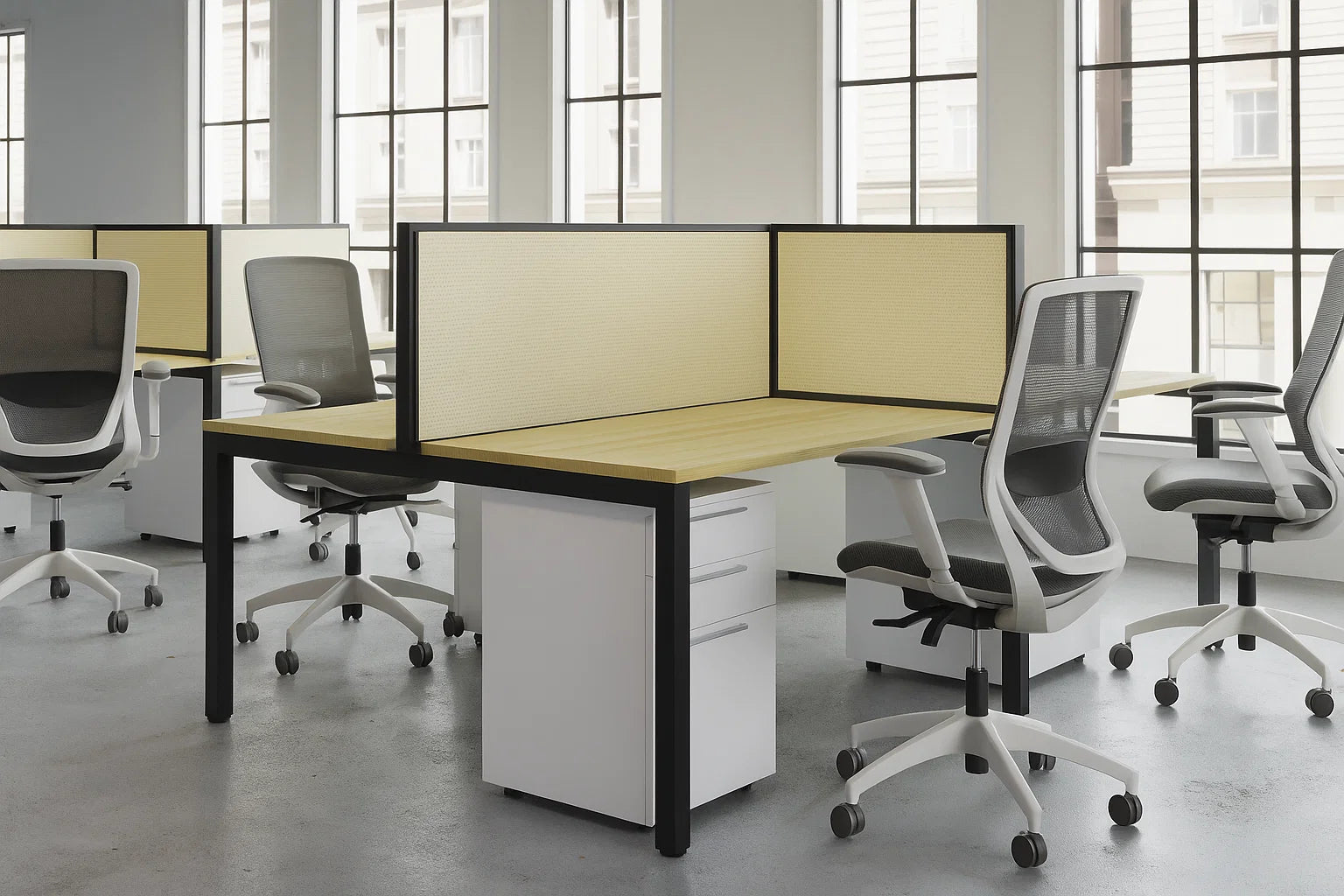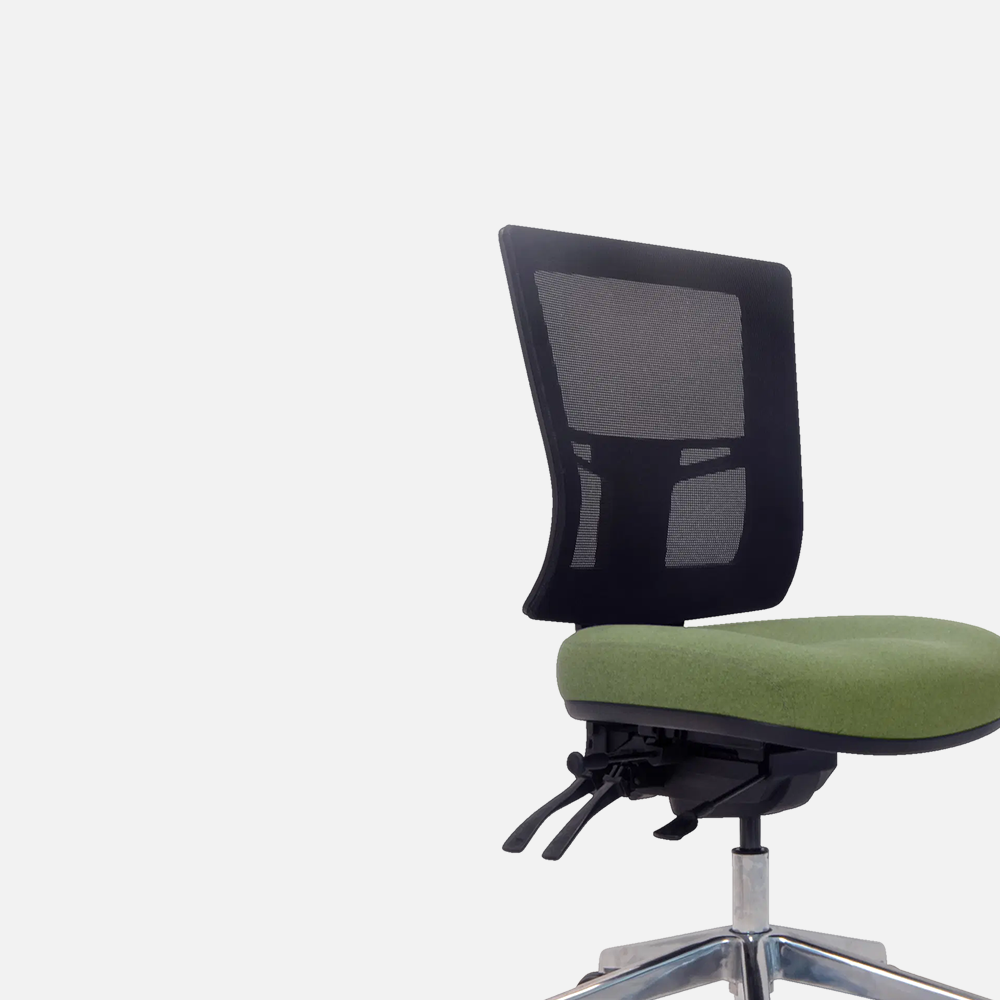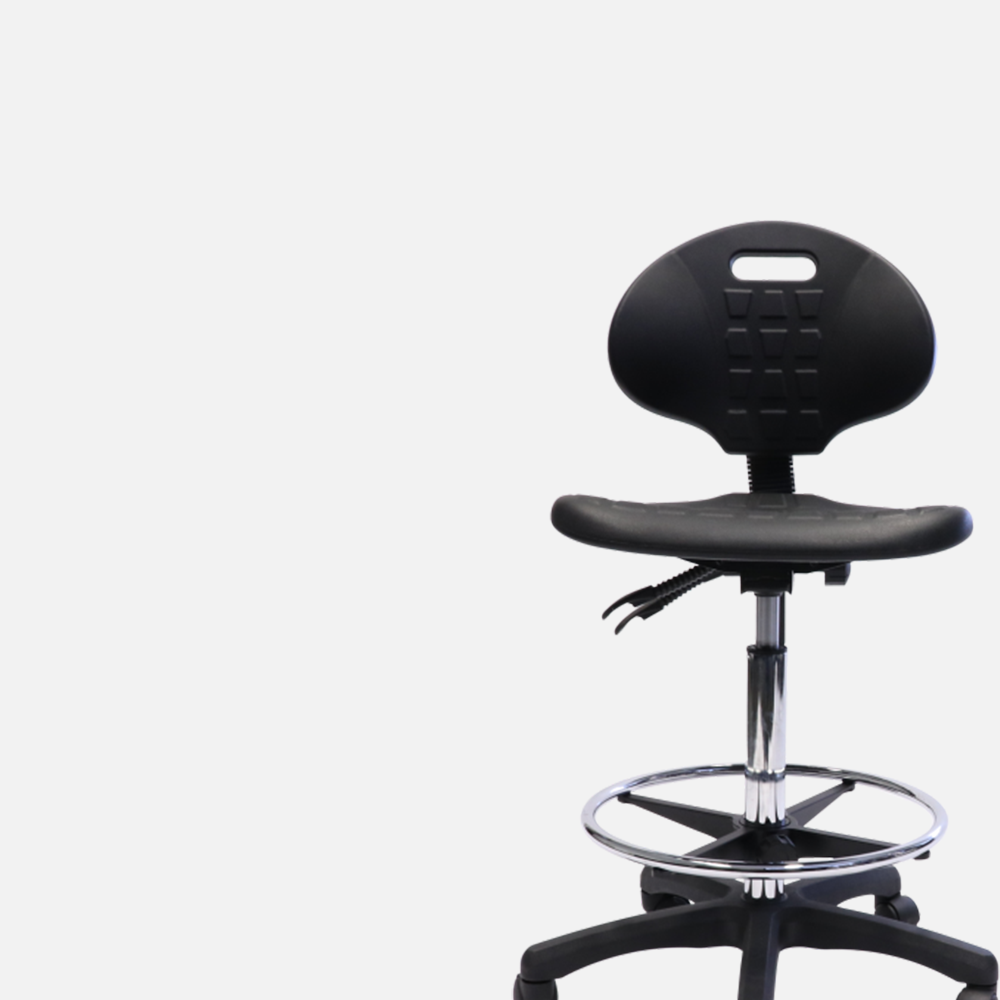Why Investing in Ergonomic Seating Supports Health, Productivity, and Wellbeing in Modern Australian Workplaces
Table of Contents
- Introduction
- Why Ergonomic Office Chairs Matter
- Health Impacts of Prolonged Sitting
- Productivity and Business Outcomes
- National Ergonomic Standards and Compliance
- Procurement Mistakes to Avoid
- Ergonomics for Hybrid and Home Work
- Emerging Innovations in Ergonomic Seating
- Procurement Recommendations for Australian Workplaces
- Conclusion & Next Steps
- References
Introduction
In today’s knowledge economy, many Australian workers spend the majority of their day seated. Yet, prolonged sitting is now recognised as a significant occupational health risk — contributing to increased rates of musculoskeletal disorders (MSDs), cardiovascular disease, metabolic disorders, and mental health challenges.
According to Safe Work Australia, MSDs are the leading cause of workers’ compensation claims nationwide, accounting for more than 50% of serious claims. Meanwhile, hybrid work models and remote work have made home office ergonomics a new area of focus for employers.
High-quality ergonomic office chairs and task seating are proven interventions to help mitigate these risks. When combined with movement-friendly workplace policies, they can improve employee wellbeing, productivity, and business outcomes.
This comprehensive research report reviews current evidence, national standards, emerging trends, and practical procurement recommendations — helping Australian businesses, government agencies, and education institutions make informed investments in ergonomic seating.
Why Ergonomic Office Chairs Matter
Not all office chairs are created equal. Many so-called "ergonomic" chairs on the market lack proper adjustability or do not meet recognised standards.
Certified ergonomic task chairs are specifically designed to:
- Support neutral, healthy postures during seated work.
- Encourage movement and posture variation throughout the day.
- Reduce static loading on the lumbar spine, neck, and shoulders.
- Minimise the risk of MSDs, fatigue, and discomfort.
When properly selected and adjusted, ergonomic task chairs can:
- Reduce reports of back, neck, and shoulder pain.
- Improve focus, energy levels, and cognitive performance.
- Lower rates of absenteeism and presenteeism linked to MSDs.
- Support workplace safety compliance under Australian WHS legislation.
As workplaces embrace hybrid work models, the role of ergonomic chairs is even more important — providing essential support both in the office and at home.
Explore Ergonomic Task Chairs →
Health Impacts of Prolonged Sitting
Musculoskeletal Disorders (MSDs)
MSDs are the most commonly reported occupational injuries in office environments. According to Safe Work Australia, they account for:
- ~54% of serious workers’ compensation claims.
- Millions of lost workdays annually.
- Substantial direct and indirect costs to employers.
Key risk factors for MSDs in office workers include:
- Prolonged static sitting.
- Inadequate lumbar support.
- Incorrect chair height or seat depth.
- Lack of arm support or poor armrest design.
- Excessive reach to keyboard, mouse, or screen.
Ergonomic task chairs that meet standards such as AS/NZS 4438 and AFRDI Level 6 are designed to address these factors, providing:
- Adjustable seat height and depth.
- Adjustable lumbar support.
- Backrest tilt and recline to promote movement.
- Appropriate seat cushioning and stability.
Numerous studies show that ergonomic chair interventions result in:
- Significant reductions in reports of low back pain.
- Reduced neck and shoulder discomfort.
- Improved overall comfort and task performance.
Without proper ergonomic support, the risks of MSD development increase significantly — both in office and home settings.
Cardiovascular and Metabolic Health
Prolonged sitting also contributes to a range of cardiovascular and metabolic health risks.
Research consistently shows that:
- Office workers who sit for 8+ hours per day are at significantly higher risk of heart disease.
- Sedentary behaviour is an independent risk factor for Type 2 diabetes.
- Prolonged static sitting impairs vascular function and leads to reduced glucose uptake.
Studies published in journals such as The Lancet and Diabetes Care confirm that reducing sedentary time through:
- Use of sit-stand desks.
- Encouraging frequent posture changes.
- Integrating movement into the workday.
...can improve cardiovascular markers and metabolic health outcomes.
While no chair alone can completely eliminate sedentary risks, ergonomic task chairs that promote dynamic sitting are a critical part of an integrated solution.
Mental Health and Cognitive Wellbeing
The impact of poor ergonomics and prolonged sitting extends beyond physical health.
Office workers who spend long hours sitting in non-ergonomic chairs are more likely to experience:
- Fatigue.
- Decreased concentration and cognitive performance.
- Lower mood and higher rates of depression and anxiety (Zhai et al., 2015).
In contrast, workplaces that provide movement-friendly environments — including properly selected ergonomic chairs — report:
- Improved employee energy and focus.
- Higher work engagement.
- Better overall mental wellbeing.
Ergonomic task chairs with dynamic features, such as tilt and recline mechanisms and adjustable lumbar support, help reduce static muscle loading and promote healthy micro-movements — supporting both physical and mental performance.
Productivity and Business Outcomes
Beyond health and compliance benefits, investing in ergonomic seating delivers significant business value:
ROI of Ergonomic Seating
A range of studies and case reviews show that providing high-quality ergonomic chairs can result in:
- 15–20% productivity improvements (Washington State Department of Labor & Industries, 2021).
- 67% reduction in MSD-related absenteeism (American Journal of Public Health).
- Return on investment (ROI) commonly between 3:1 and 10:1.
Business Benefits
- Reduced lost time injuries (LTIs).
- Lower workers’ compensation costs.
- Improved talent attraction and retention — employees value workplaces that invest in wellbeing and safety.
- Enhanced employee satisfaction and engagement.
- Higher levels of focus, accuracy, and cognitive performance.
Why Chairs Matter for Productivity
While an ergonomic workstation includes multiple components, the task chair is the foundation:
- It is the primary interface between the worker and their environment for 6–10 hours/day.
- Poor seating leads to micro-discomforts that sap energy and focus.
- Proper seating reduces fatigue and encourages healthy movement patterns.
Case Example
In one large-scale intervention studied by Washington State DLI:
- A company introduced standards-compliant ergonomic chairs to 4000+ employees.
- Reported a 47% reduction in MSD cases.
- Realised a 15% increase in employee-reported productivity within 12 months.
The conclusion is clear: investing in ergonomic task chairs pays off both in health outcomes and in bottom-line business performance.
Discover Our Ergonomic Task Chairs →
National Ergonomic Standards and Compliance
When selecting ergonomic office chairs, it is critical to base procurement decisions on recognised national and international standards — not marketing claims alone.
Here is a summary of the most relevant ergonomic chair standards used in Australia and internationally:
Australia & New Zealand
- The principal Australian standard for ergonomic seating is AS/NZS 4438:1997 — Height Adjustable Swivel Chairs.
- AS/NZS 4438 defines:
- Minimum performance and durability requirements for office chairs.
- Safety and stability criteria.
- Key ergonomic features required for adjustability and user fit.
- Chairs tested to AFRDI Level 6 Blue Tick Certification meet or exceed AS/NZS 4438 and are suitable for:
- Commercial office use (8+ hours/day).
- Users up to at least 110 kg — many chairs rated for 135+ kg with additional testing.
- Adjustability across key ergonomic dimensions:
- Seat height and depth.
- Backrest height and lumbar support.
- Armrest height and width (if fitted).
- Back tilt and seat tilt mechanisms.
Procurement Tip: Request proof of AFRDI Level 6 certification for any chair purchased for Australian workplace use — particularly in public sector, government, and education environments where WHS compliance is mandated.
United Kingdom & Europe
- The main European ergonomic chair standard is BS EN 1335 — Office Work Chair Standard.
- BS EN 1335 includes:
- Ergonomic dimension requirements to fit a broad range of users.
- Adjustability features.
- Mechanical durability and stability testing.
- UK and European public sector tenders frequently specify compliance with EN 1335 to ensure health and safety requirements are met.
United States
- The key American standards include:
- ANSI/BIFMA X5.1 — General Purpose Office Chairs.
- BIFMA G1 — Ergonomic Guidelines.
- HFES 100 — Human Factors Engineering of Computer Workstations.
- While ANSI/BIFMA X5.1 focuses primarily on durability and stability, BIFMA G1 provides valuable ergonomic guidance — including recommended adjustability ranges and fit criteria for ergonomic chairs.
- Chairs used in US federal workplaces are typically required to comply with both BIFMA durability standards and ergonomic fit guidelines.
Procurement Mistakes to Avoid
Based on extensive industry research, here are the most common mistakes that Australian organisations make when procuring office chairs:
✅ Mistake 1 — Buying on Appearance, Not Performance
Many chairs that look "ergonomic" lack the adjustability and support features required for sustained office use. Always verify standards compliance and test before purchasing.
✅ Mistake 2 — Ignoring Weight and Fit Range
Chairs must suit the diverse anthropometric needs of your workforce. Chairs with insufficient adjustability may not fit all users, increasing injury risk.
✅ Mistake 3 — Failing to Provide Adjustment Training
Even the best chair is ineffective if staff do not know how to adjust it. Provide chair setup training or video tutorials during onboarding and office moves.
✅ Mistake 4 — Overlooking Warranty and Durability
Non-compliant or cheap chairs often fail prematurely. Chairs rated to AFRDI Level 6 or equivalent standards are engineered for:
- Durability under commercial use.
- Compliance with Australian WHS standards.
- Warranty periods of 5–10 years — a key value indicator.
Ergonomics for Hybrid and Home Work
With hybrid and remote work models now permanent in many Australian workplaces, home office ergonomics has become a critical factor for reducing MSD risk.
Common Hybrid Work Challenges
- Staff working on dining chairs or low-cost task chairs at home.
- Inadequate lumbar support, leading to increased reports of back and neck pain.
- Variability in fit and support across home and office settings.
Best Practice Recommendations
- Provide or subsidise standards-compliant ergonomic task chairs for home use.
- Offer virtual ergonomic assessments for remote workers.
- Develop home office setup guides covering chair adjustment, desk height, monitor placement, and movement strategies.
- Consider providing portable ergonomic chairs or mobile seating options that support a consistent experience across home and office.
Organisations that proactively support hybrid ergonomics are more likely to:
- Reduce MSD incidence across remote work settings.
- Enhance staff satisfaction and wellbeing.
- Improve employee loyalty and retention.
Emerging Innovations in Ergonomic Seating
The field of ergonomic seating is evolving rapidly, driven by advances in technology, materials science, and a growing understanding of the importance of movement-friendly work environments.
AI-Powered Posture Monitoring
New office chairs and accessories are now integrating embedded sensors and AI-driven feedback systems that:
- Monitor sitting posture and detect slouching.
- Provide real-time feedback to the user via apps or visual cues.
- Encourage micro-movements and posture variation throughout the workday.
While these systems are still emerging, they show promise in helping combat the effects of static sitting — especially for desk-bound knowledge workers.
Dynamic Seating Designs
Modern ergonomic chairs increasingly incorporate:
- Dynamic seat pan tilting and synchro-tilt mechanisms.
- Backrest designs that support continuous micro-movements.
- Material innovations such as breathable mesh that adapts to the user's body and movement.
Dynamic seating aligns with the key ergonomic principle: "The best posture is the next posture." Encouraging even small movements helps reduce fatigue, improves circulation, and promotes overall musculoskeletal health.
Hybrid Work Seating Solutions
As hybrid work models become the norm, there is growing demand for seating that:
- Is portable or easily configurable for both home and office use.
- Maintains high ergonomic performance across diverse work environments.
- Supports rapid adjustment for hot-desking and shared spaces.
Chairs with intuitive adjustment controls and flexible features are ideal for this new era of work.
Procurement Recommendations for Australian Workplaces
To ensure your ergonomic chair investment delivers maximum value, follow these best practice recommendations:
✅ Standards Compliance
- In Australia, always require AFRDI Level 6 Blue Tick certification as a minimum benchmark.
- Verify chairs also comply with AS/NZS 4438:1997 and relevant international standards (EN 1335, ANSI/BIFMA X5.1 where applicable).
✅ Full Adjustability
- Seat height and seat depth.
- Backrest height and lumbar support.
- Backrest tilt and synchro-tilt functions.
- Armrest height, width, and depth adjustment.
✅ Fit for Diverse Users
- Select chairs that accommodate a broad range of body sizes and types.
- Ensure chairs meet commercial durability and safety standards for higher weight ranges where needed.
✅ Durability and Warranty
- Prefer chairs with 5–10 year commercial warranties.
- Verify test results and certification — not just marketing claims.
✅ Employee Training and Setup
- Provide training on chair adjustment and ergonomics during onboarding.
- Offer periodic ergonomic assessments and refreshers to support long-term wellbeing.
By following these recommendations, your organisation can maximise the health, safety, and performance benefits of ergonomic seating investments — while ensuring full compliance with WHS obligations.
Conclusion & Next Steps
Ergonomic office chairs are a proven foundation for healthier, more productive workplaces.
In an era of hybrid work and increasing focus on employee wellbeing, investing in standards-compliant ergonomic seating is both a business priority and a compliance necessity.
Summary Recommendations:
- Upgrade seating to AFRDI Level 6 certified ergonomic task chairs.
- Support movement-friendly workplace cultures that reduce sedentary risks.
- Address ergonomic risks across both office and home work environments.
- Provide training and ongoing support to help staff get the most from their ergonomic chairs.
Investing in ergonomic seating supports:
- Employee health, wellbeing, and engagement.
- Business productivity and performance.
- Compliance with Australian WHS standards.
Explore Our Ergonomic Task Seating Collection →
References
- Black, N., et al. (2018). Prevalence of musculoskeletal disorders in Australian office workers. Ergonomics, 61(1), 69–80.
- Dempsey, P. C., et al. (2017). Breaking up prolonged sitting improves postprandial glucose and insulin responses. Diabetes Care, 40(7), 1–9.
- Dunstan, D. W., et al. (2012). Too much sitting — a health hazard. Diabetes Research and Clinical Practice, 97(3), 368–376.
- Ekelund, U., et al. (2016). Does physical activity attenuate, or even eliminate, the detrimental association of sitting time with mortality? The Lancet, 388(10051), 1302–1310.
- Safe Work Australia. (2023). Work-related musculoskeletal disorders in Australia.
- Washington State Department of Labor & Industries. (2021). Ergonomics ROI Case Studies.
- Zhai, L., et al. (2015). Sedentary behaviour and the risk of depression. British Journal of Sports Medicine, 49(11), 705–709.








Leave a comment
This site is protected by hCaptcha and the hCaptcha Privacy Policy and Terms of Service apply.